Leadership, Management, and Operations: A Comprehensive Analysis
VerifiedAdded on 2020/01/07
|20
|4669
|2558
Report
AI Summary
This report provides a comprehensive analysis of leadership and management, comparing the roles and characteristics of leaders and managers within an organizational context. It delves into leadership roles, including interpersonal, informational, and decisional aspects, while also highlighting managerial traits. The report then explores the application of leadership theories and models such as situational leadership, contingency theory, and system leadership, using practical examples to illustrate their implementation. Furthermore, it discusses the importance and value of operations management in achieving business objectives, emphasizing approaches like total quality management (TQM) and just-in-time (JIT) inventory. The report concludes by examining how these operational strategies contribute to productivity, customer satisfaction, and efficient resource allocation, underscoring the significance of effective leadership and management in driving organizational success.
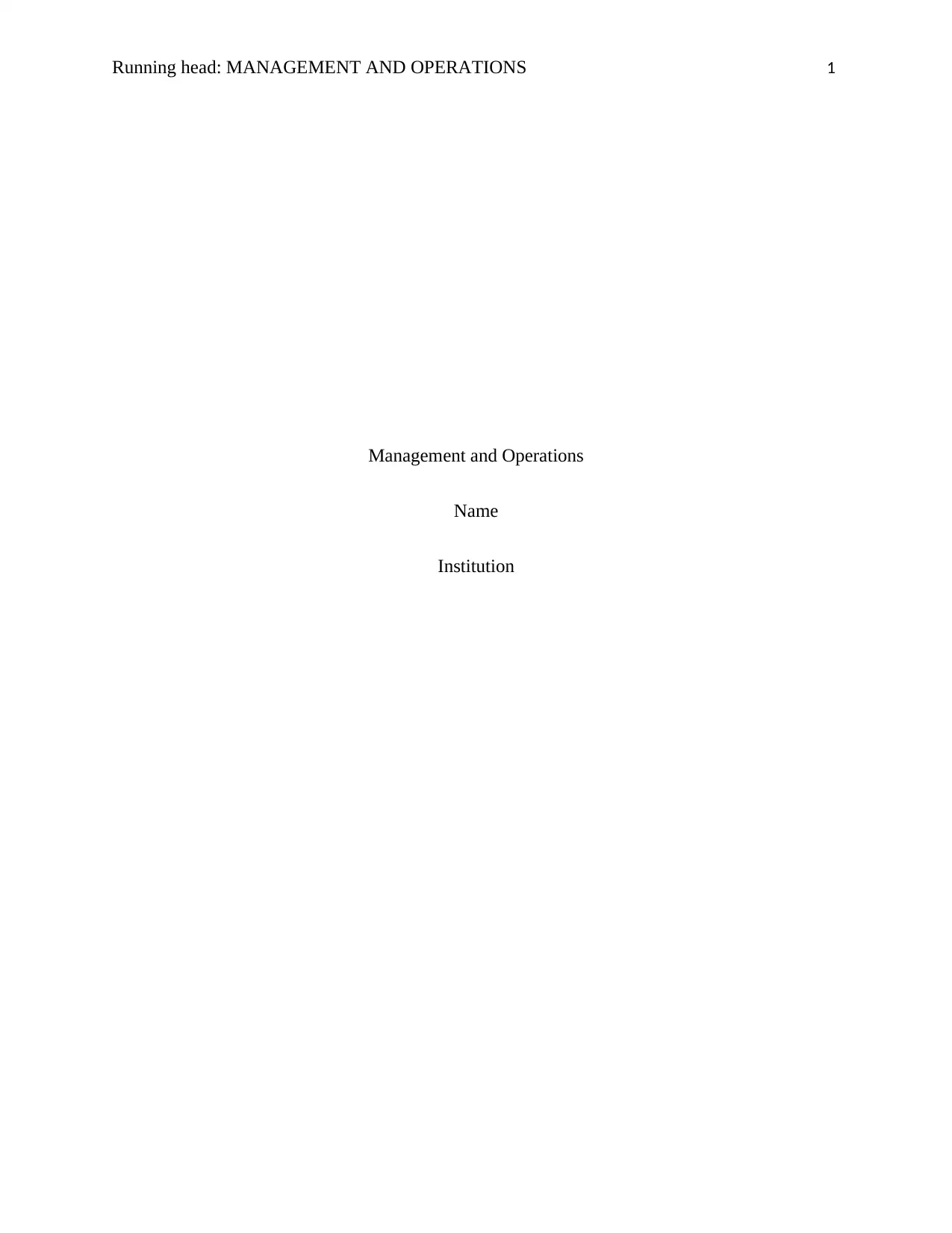
Running head: MANAGEMENT AND OPERATIONS 1
Management and Operations
Name
Institution
Management and Operations
Name
Institution
Paraphrase This Document
Need a fresh take? Get an instant paraphrase of this document with our AI Paraphraser
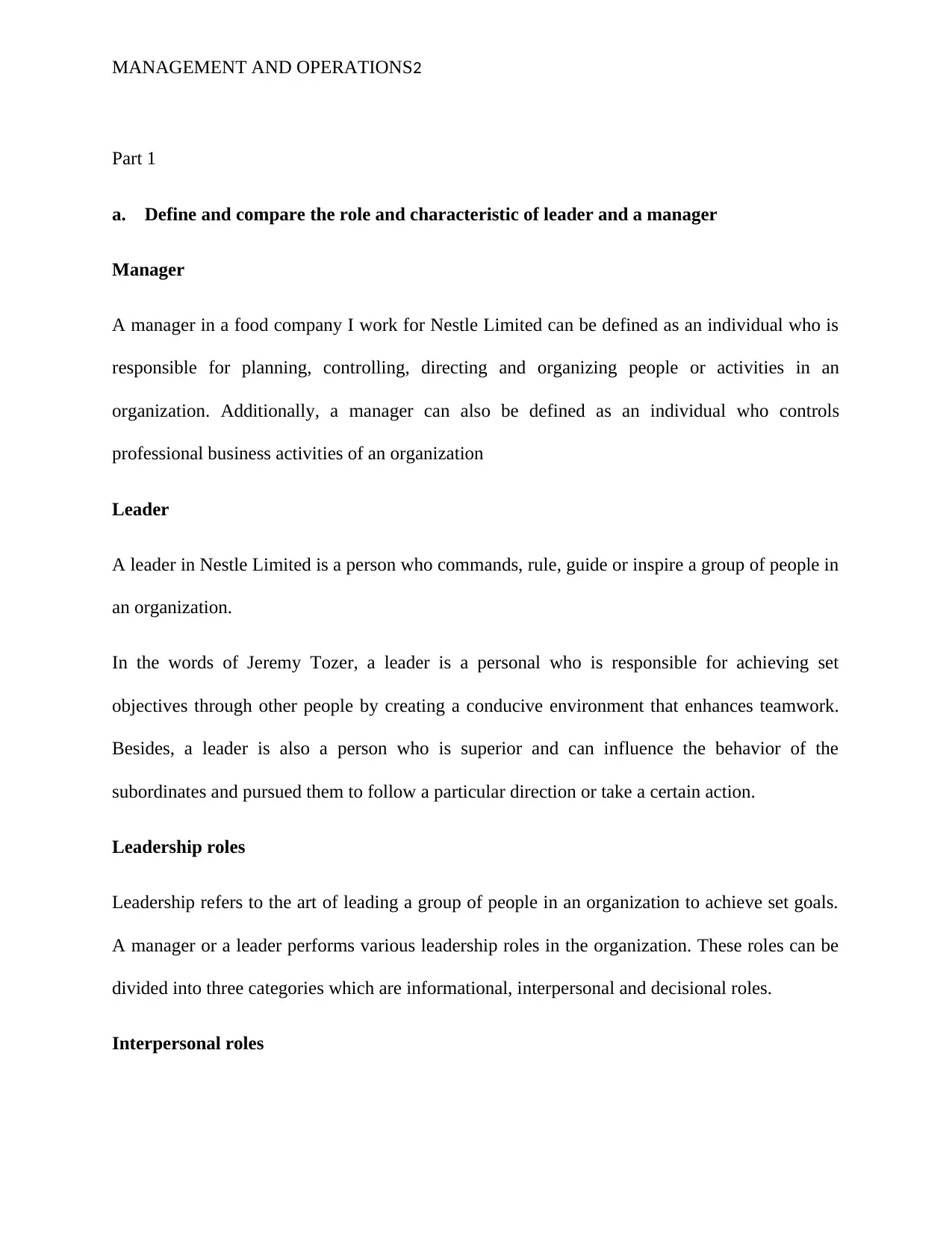
MANAGEMENT AND OPERATIONS2
Part 1
a. Define and compare the role and characteristic of leader and a manager
Manager
A manager in a food company I work for Nestle Limited can be defined as an individual who is
responsible for planning, controlling, directing and organizing people or activities in an
organization. Additionally, a manager can also be defined as an individual who controls
professional business activities of an organization
Leader
A leader in Nestle Limited is a person who commands, rule, guide or inspire a group of people in
an organization.
In the words of Jeremy Tozer, a leader is a personal who is responsible for achieving set
objectives through other people by creating a conducive environment that enhances teamwork.
Besides, a leader is also a person who is superior and can influence the behavior of the
subordinates and pursued them to follow a particular direction or take a certain action.
Leadership roles
Leadership refers to the art of leading a group of people in an organization to achieve set goals.
A manager or a leader performs various leadership roles in the organization. These roles can be
divided into three categories which are informational, interpersonal and decisional roles.
Interpersonal roles
Part 1
a. Define and compare the role and characteristic of leader and a manager
Manager
A manager in a food company I work for Nestle Limited can be defined as an individual who is
responsible for planning, controlling, directing and organizing people or activities in an
organization. Additionally, a manager can also be defined as an individual who controls
professional business activities of an organization
Leader
A leader in Nestle Limited is a person who commands, rule, guide or inspire a group of people in
an organization.
In the words of Jeremy Tozer, a leader is a personal who is responsible for achieving set
objectives through other people by creating a conducive environment that enhances teamwork.
Besides, a leader is also a person who is superior and can influence the behavior of the
subordinates and pursued them to follow a particular direction or take a certain action.
Leadership roles
Leadership refers to the art of leading a group of people in an organization to achieve set goals.
A manager or a leader performs various leadership roles in the organization. These roles can be
divided into three categories which are informational, interpersonal and decisional roles.
Interpersonal roles
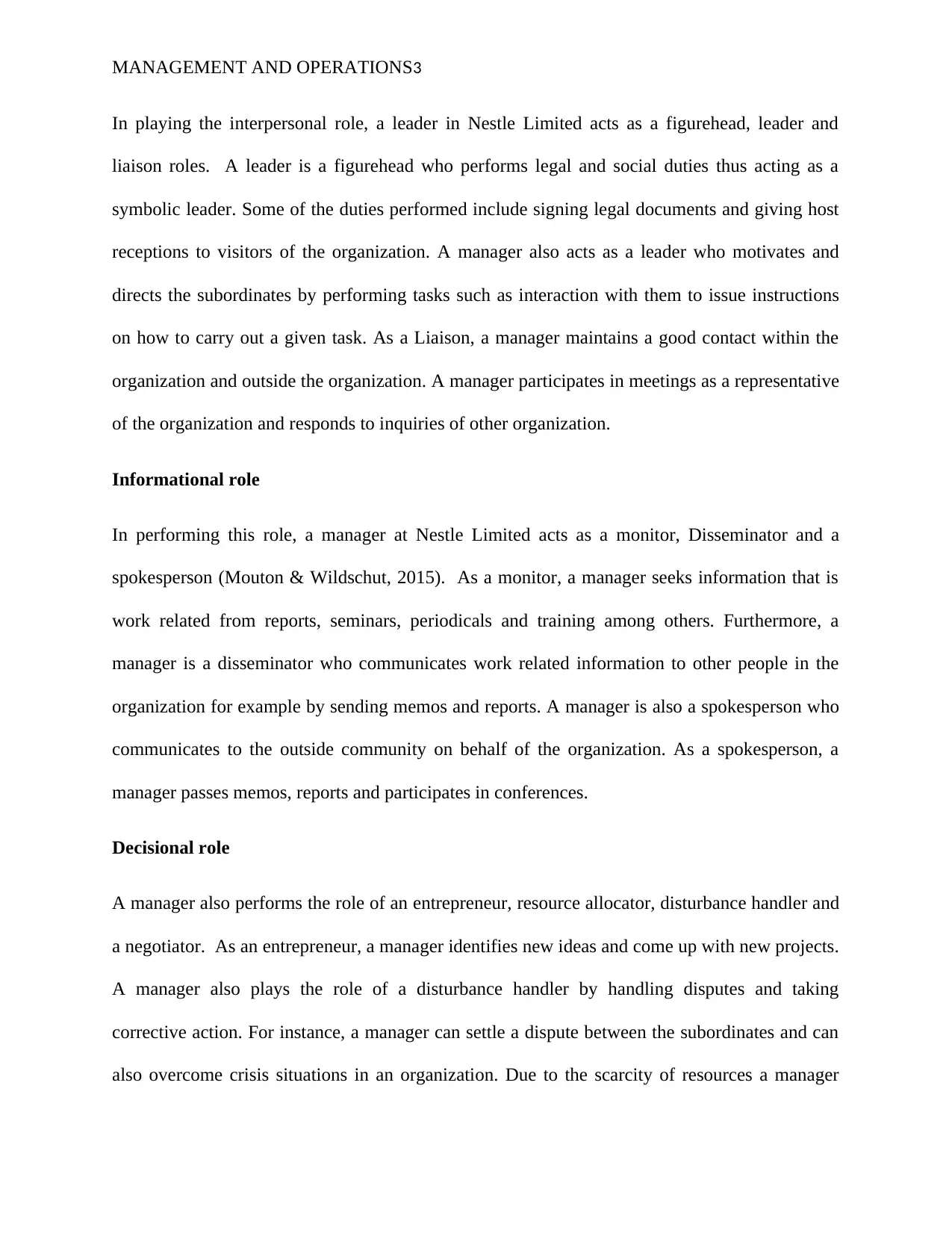
MANAGEMENT AND OPERATIONS3
In playing the interpersonal role, a leader in Nestle Limited acts as a figurehead, leader and
liaison roles. A leader is a figurehead who performs legal and social duties thus acting as a
symbolic leader. Some of the duties performed include signing legal documents and giving host
receptions to visitors of the organization. A manager also acts as a leader who motivates and
directs the subordinates by performing tasks such as interaction with them to issue instructions
on how to carry out a given task. As a Liaison, a manager maintains a good contact within the
organization and outside the organization. A manager participates in meetings as a representative
of the organization and responds to inquiries of other organization.
Informational role
In performing this role, a manager at Nestle Limited acts as a monitor, Disseminator and a
spokesperson (Mouton & Wildschut, 2015). As a monitor, a manager seeks information that is
work related from reports, seminars, periodicals and training among others. Furthermore, a
manager is a disseminator who communicates work related information to other people in the
organization for example by sending memos and reports. A manager is also a spokesperson who
communicates to the outside community on behalf of the organization. As a spokesperson, a
manager passes memos, reports and participates in conferences.
Decisional role
A manager also performs the role of an entrepreneur, resource allocator, disturbance handler and
a negotiator. As an entrepreneur, a manager identifies new ideas and come up with new projects.
A manager also plays the role of a disturbance handler by handling disputes and taking
corrective action. For instance, a manager can settle a dispute between the subordinates and can
also overcome crisis situations in an organization. Due to the scarcity of resources a manager
In playing the interpersonal role, a leader in Nestle Limited acts as a figurehead, leader and
liaison roles. A leader is a figurehead who performs legal and social duties thus acting as a
symbolic leader. Some of the duties performed include signing legal documents and giving host
receptions to visitors of the organization. A manager also acts as a leader who motivates and
directs the subordinates by performing tasks such as interaction with them to issue instructions
on how to carry out a given task. As a Liaison, a manager maintains a good contact within the
organization and outside the organization. A manager participates in meetings as a representative
of the organization and responds to inquiries of other organization.
Informational role
In performing this role, a manager at Nestle Limited acts as a monitor, Disseminator and a
spokesperson (Mouton & Wildschut, 2015). As a monitor, a manager seeks information that is
work related from reports, seminars, periodicals and training among others. Furthermore, a
manager is a disseminator who communicates work related information to other people in the
organization for example by sending memos and reports. A manager is also a spokesperson who
communicates to the outside community on behalf of the organization. As a spokesperson, a
manager passes memos, reports and participates in conferences.
Decisional role
A manager also performs the role of an entrepreneur, resource allocator, disturbance handler and
a negotiator. As an entrepreneur, a manager identifies new ideas and come up with new projects.
A manager also plays the role of a disturbance handler by handling disputes and taking
corrective action. For instance, a manager can settle a dispute between the subordinates and can
also overcome crisis situations in an organization. Due to the scarcity of resources a manager
⊘ This is a preview!⊘
Do you want full access?
Subscribe today to unlock all pages.

Trusted by 1+ million students worldwide
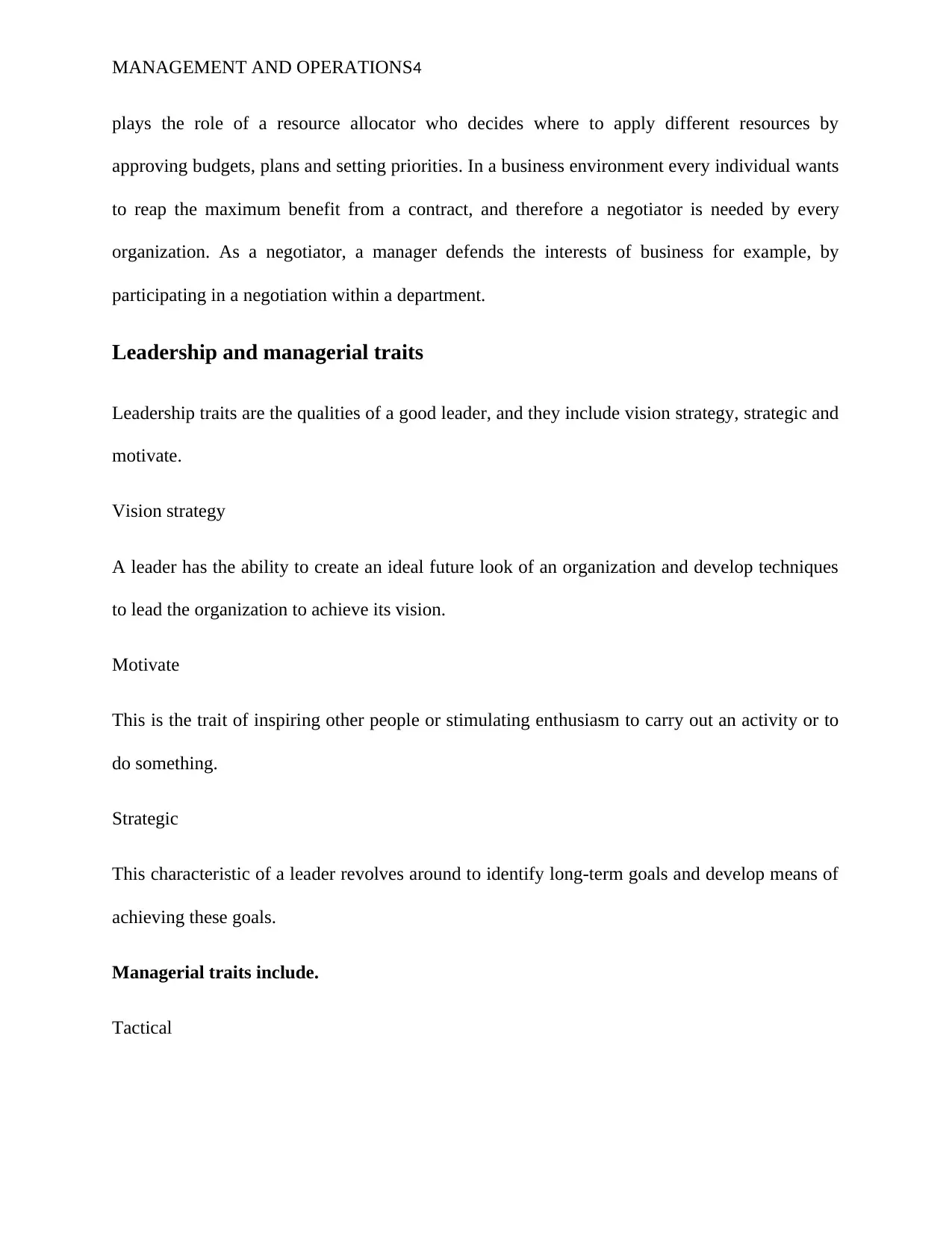
MANAGEMENT AND OPERATIONS4
plays the role of a resource allocator who decides where to apply different resources by
approving budgets, plans and setting priorities. In a business environment every individual wants
to reap the maximum benefit from a contract, and therefore a negotiator is needed by every
organization. As a negotiator, a manager defends the interests of business for example, by
participating in a negotiation within a department.
Leadership and managerial traits
Leadership traits are the qualities of a good leader, and they include vision strategy, strategic and
motivate.
Vision strategy
A leader has the ability to create an ideal future look of an organization and develop techniques
to lead the organization to achieve its vision.
Motivate
This is the trait of inspiring other people or stimulating enthusiasm to carry out an activity or to
do something.
Strategic
This characteristic of a leader revolves around to identify long-term goals and develop means of
achieving these goals.
Managerial traits include.
Tactical
plays the role of a resource allocator who decides where to apply different resources by
approving budgets, plans and setting priorities. In a business environment every individual wants
to reap the maximum benefit from a contract, and therefore a negotiator is needed by every
organization. As a negotiator, a manager defends the interests of business for example, by
participating in a negotiation within a department.
Leadership and managerial traits
Leadership traits are the qualities of a good leader, and they include vision strategy, strategic and
motivate.
Vision strategy
A leader has the ability to create an ideal future look of an organization and develop techniques
to lead the organization to achieve its vision.
Motivate
This is the trait of inspiring other people or stimulating enthusiasm to carry out an activity or to
do something.
Strategic
This characteristic of a leader revolves around to identify long-term goals and develop means of
achieving these goals.
Managerial traits include.
Tactical
Paraphrase This Document
Need a fresh take? Get an instant paraphrase of this document with our AI Paraphraser
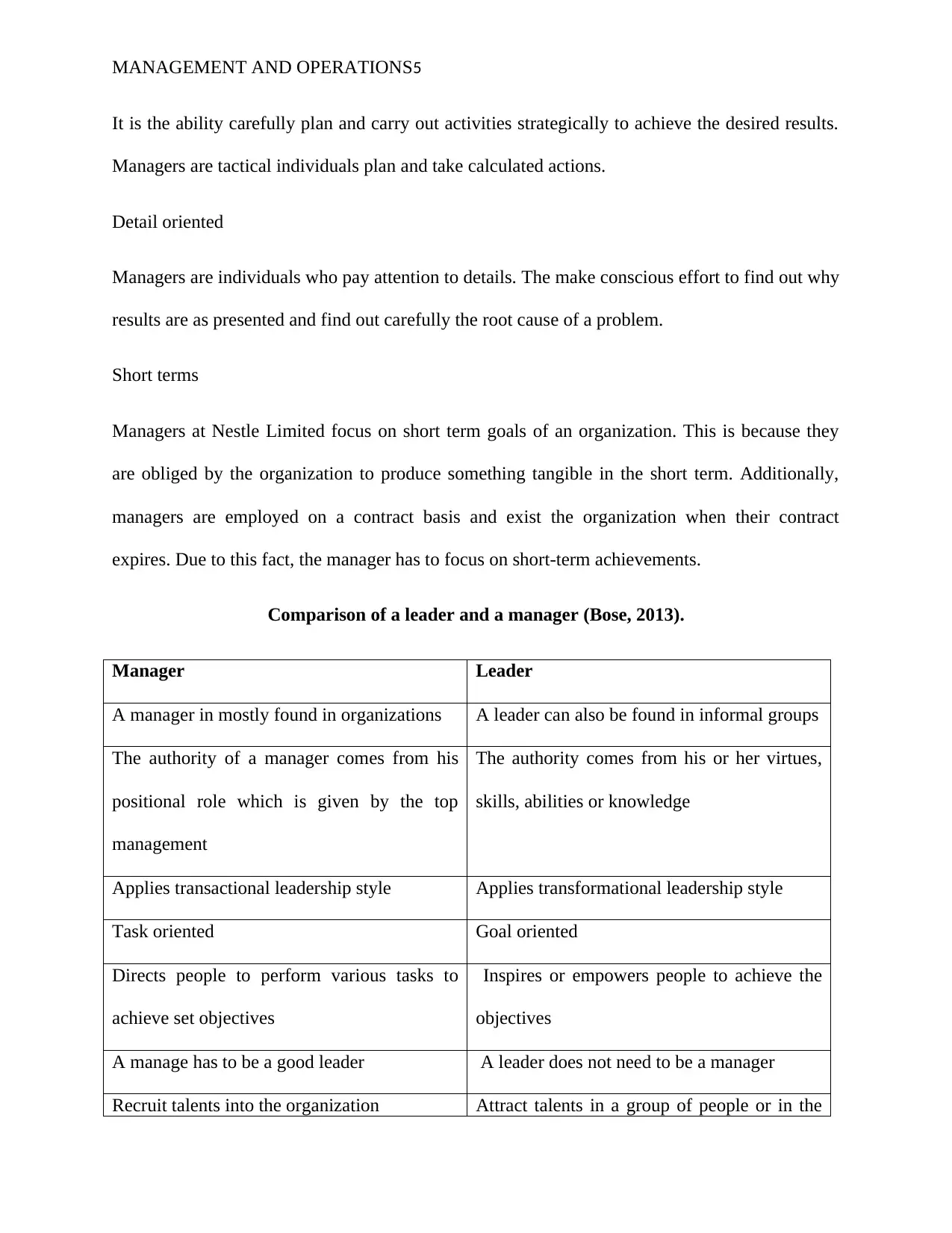
MANAGEMENT AND OPERATIONS5
It is the ability carefully plan and carry out activities strategically to achieve the desired results.
Managers are tactical individuals plan and take calculated actions.
Detail oriented
Managers are individuals who pay attention to details. The make conscious effort to find out why
results are as presented and find out carefully the root cause of a problem.
Short terms
Managers at Nestle Limited focus on short term goals of an organization. This is because they
are obliged by the organization to produce something tangible in the short term. Additionally,
managers are employed on a contract basis and exist the organization when their contract
expires. Due to this fact, the manager has to focus on short-term achievements.
Comparison of a leader and a manager (Bose, 2013).
Manager Leader
A manager in mostly found in organizations A leader can also be found in informal groups
The authority of a manager comes from his
positional role which is given by the top
management
The authority comes from his or her virtues,
skills, abilities or knowledge
Applies transactional leadership style Applies transformational leadership style
Task oriented Goal oriented
Directs people to perform various tasks to
achieve set objectives
Inspires or empowers people to achieve the
objectives
A manage has to be a good leader A leader does not need to be a manager
Recruit talents into the organization Attract talents in a group of people or in the
It is the ability carefully plan and carry out activities strategically to achieve the desired results.
Managers are tactical individuals plan and take calculated actions.
Detail oriented
Managers are individuals who pay attention to details. The make conscious effort to find out why
results are as presented and find out carefully the root cause of a problem.
Short terms
Managers at Nestle Limited focus on short term goals of an organization. This is because they
are obliged by the organization to produce something tangible in the short term. Additionally,
managers are employed on a contract basis and exist the organization when their contract
expires. Due to this fact, the manager has to focus on short-term achievements.
Comparison of a leader and a manager (Bose, 2013).
Manager Leader
A manager in mostly found in organizations A leader can also be found in informal groups
The authority of a manager comes from his
positional role which is given by the top
management
The authority comes from his or her virtues,
skills, abilities or knowledge
Applies transactional leadership style Applies transformational leadership style
Task oriented Goal oriented
Directs people to perform various tasks to
achieve set objectives
Inspires or empowers people to achieve the
objectives
A manage has to be a good leader A leader does not need to be a manager
Recruit talents into the organization Attract talents in a group of people or in the
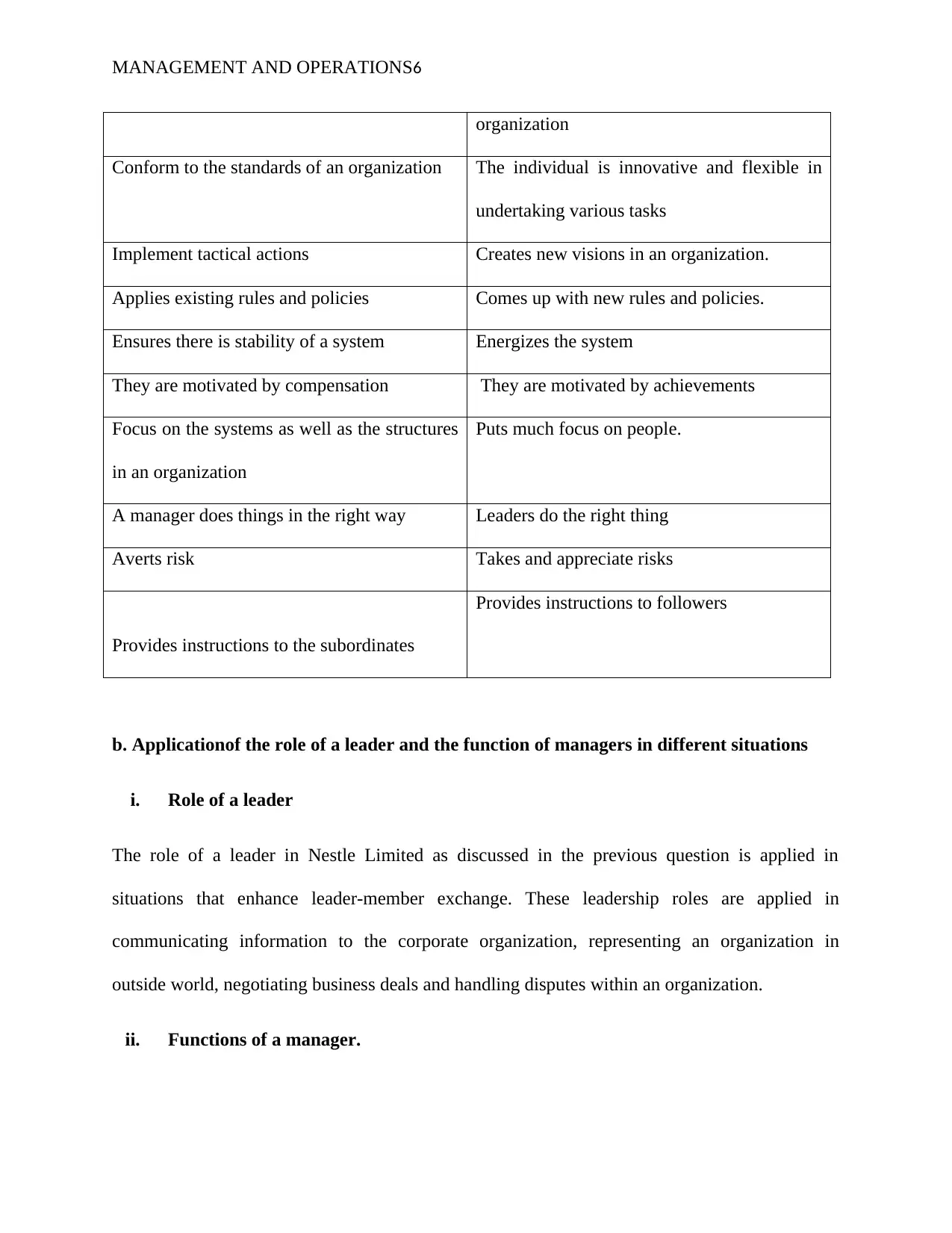
MANAGEMENT AND OPERATIONS6
organization
Conform to the standards of an organization The individual is innovative and flexible in
undertaking various tasks
Implement tactical actions Creates new visions in an organization.
Applies existing rules and policies Comes up with new rules and policies.
Ensures there is stability of a system Energizes the system
They are motivated by compensation They are motivated by achievements
Focus on the systems as well as the structures
in an organization
Puts much focus on people.
A manager does things in the right way Leaders do the right thing
Averts risk Takes and appreciate risks
Provides instructions to the subordinates
Provides instructions to followers
b. Applicationof the role of a leader and the function of managers in different situations
i. Role of a leader
The role of a leader in Nestle Limited as discussed in the previous question is applied in
situations that enhance leader-member exchange. These leadership roles are applied in
communicating information to the corporate organization, representing an organization in
outside world, negotiating business deals and handling disputes within an organization.
ii. Functions of a manager.
organization
Conform to the standards of an organization The individual is innovative and flexible in
undertaking various tasks
Implement tactical actions Creates new visions in an organization.
Applies existing rules and policies Comes up with new rules and policies.
Ensures there is stability of a system Energizes the system
They are motivated by compensation They are motivated by achievements
Focus on the systems as well as the structures
in an organization
Puts much focus on people.
A manager does things in the right way Leaders do the right thing
Averts risk Takes and appreciate risks
Provides instructions to the subordinates
Provides instructions to followers
b. Applicationof the role of a leader and the function of managers in different situations
i. Role of a leader
The role of a leader in Nestle Limited as discussed in the previous question is applied in
situations that enhance leader-member exchange. These leadership roles are applied in
communicating information to the corporate organization, representing an organization in
outside world, negotiating business deals and handling disputes within an organization.
ii. Functions of a manager.
⊘ This is a preview!⊘
Do you want full access?
Subscribe today to unlock all pages.

Trusted by 1+ million students worldwide
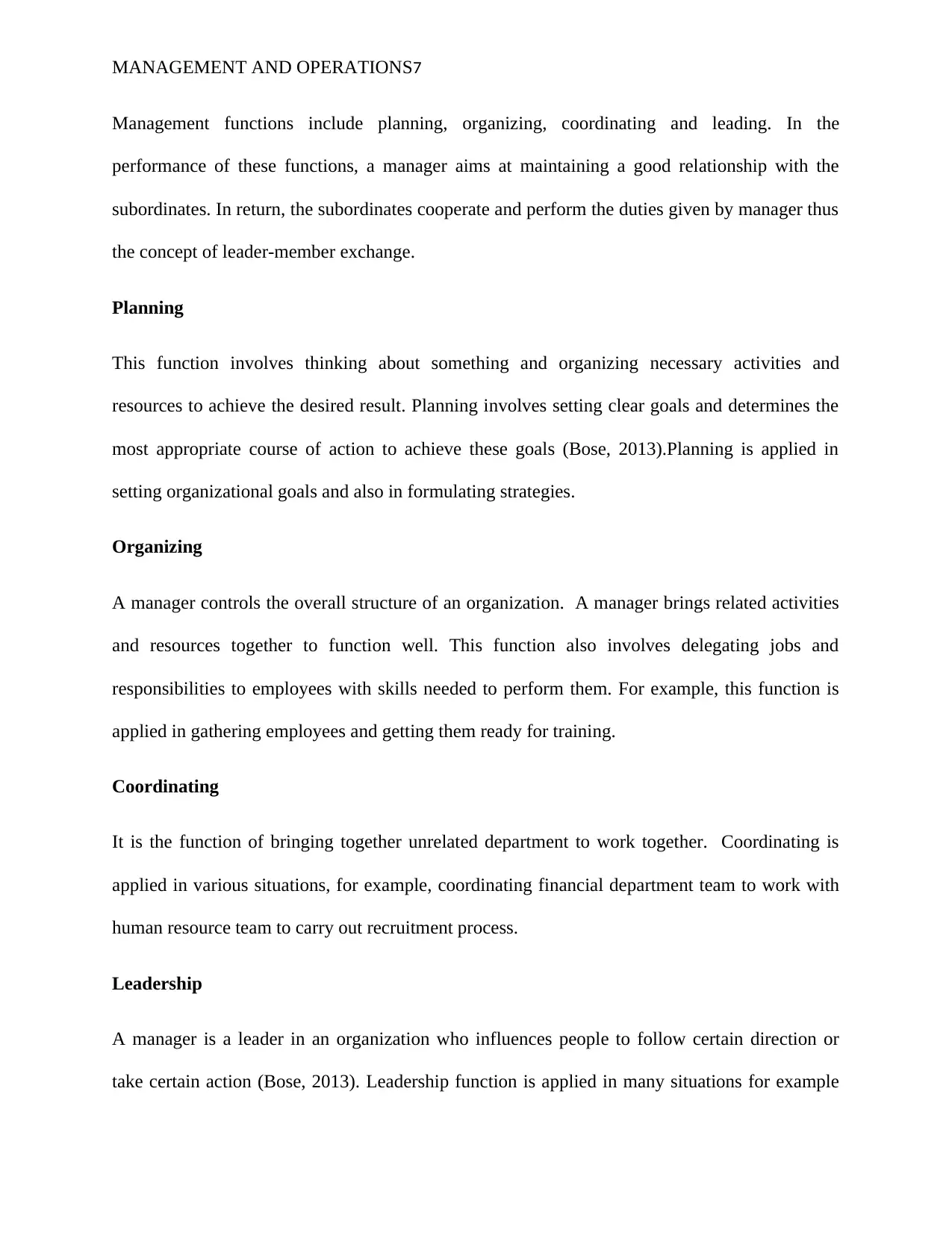
MANAGEMENT AND OPERATIONS7
Management functions include planning, organizing, coordinating and leading. In the
performance of these functions, a manager aims at maintaining a good relationship with the
subordinates. In return, the subordinates cooperate and perform the duties given by manager thus
the concept of leader-member exchange.
Planning
This function involves thinking about something and organizing necessary activities and
resources to achieve the desired result. Planning involves setting clear goals and determines the
most appropriate course of action to achieve these goals (Bose, 2013).Planning is applied in
setting organizational goals and also in formulating strategies.
Organizing
A manager controls the overall structure of an organization. A manager brings related activities
and resources together to function well. This function also involves delegating jobs and
responsibilities to employees with skills needed to perform them. For example, this function is
applied in gathering employees and getting them ready for training.
Coordinating
It is the function of bringing together unrelated department to work together. Coordinating is
applied in various situations, for example, coordinating financial department team to work with
human resource team to carry out recruitment process.
Leadership
A manager is a leader in an organization who influences people to follow certain direction or
take certain action (Bose, 2013). Leadership function is applied in many situations for example
Management functions include planning, organizing, coordinating and leading. In the
performance of these functions, a manager aims at maintaining a good relationship with the
subordinates. In return, the subordinates cooperate and perform the duties given by manager thus
the concept of leader-member exchange.
Planning
This function involves thinking about something and organizing necessary activities and
resources to achieve the desired result. Planning involves setting clear goals and determines the
most appropriate course of action to achieve these goals (Bose, 2013).Planning is applied in
setting organizational goals and also in formulating strategies.
Organizing
A manager controls the overall structure of an organization. A manager brings related activities
and resources together to function well. This function also involves delegating jobs and
responsibilities to employees with skills needed to perform them. For example, this function is
applied in gathering employees and getting them ready for training.
Coordinating
It is the function of bringing together unrelated department to work together. Coordinating is
applied in various situations, for example, coordinating financial department team to work with
human resource team to carry out recruitment process.
Leadership
A manager is a leader in an organization who influences people to follow certain direction or
take certain action (Bose, 2013). Leadership function is applied in many situations for example
Paraphrase This Document
Need a fresh take? Get an instant paraphrase of this document with our AI Paraphraser
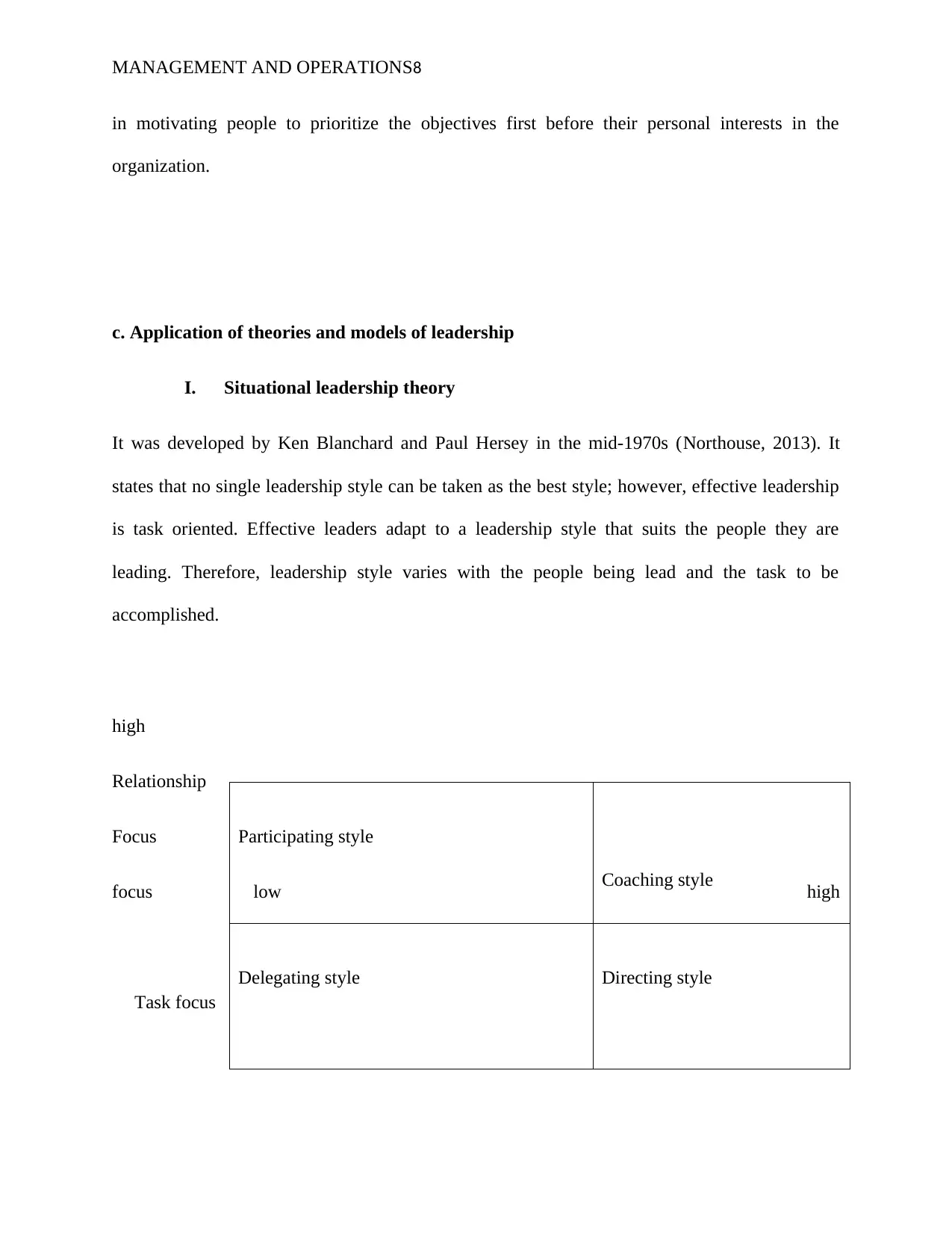
MANAGEMENT AND OPERATIONS8
in motivating people to prioritize the objectives first before their personal interests in the
organization.
c. Application of theories and models of leadership
I. Situational leadership theory
It was developed by Ken Blanchard and Paul Hersey in the mid-1970s (Northouse, 2013). It
states that no single leadership style can be taken as the best style; however, effective leadership
is task oriented. Effective leaders adapt to a leadership style that suits the people they are
leading. Therefore, leadership style varies with the people being lead and the task to be
accomplished.
high
Relationship
Focus
focus low high
Task focus
Participating style
Coaching style
Delegating style Directing style
in motivating people to prioritize the objectives first before their personal interests in the
organization.
c. Application of theories and models of leadership
I. Situational leadership theory
It was developed by Ken Blanchard and Paul Hersey in the mid-1970s (Northouse, 2013). It
states that no single leadership style can be taken as the best style; however, effective leadership
is task oriented. Effective leaders adapt to a leadership style that suits the people they are
leading. Therefore, leadership style varies with the people being lead and the task to be
accomplished.
high
Relationship
Focus
focus low high
Task focus
Participating style
Coaching style
Delegating style Directing style
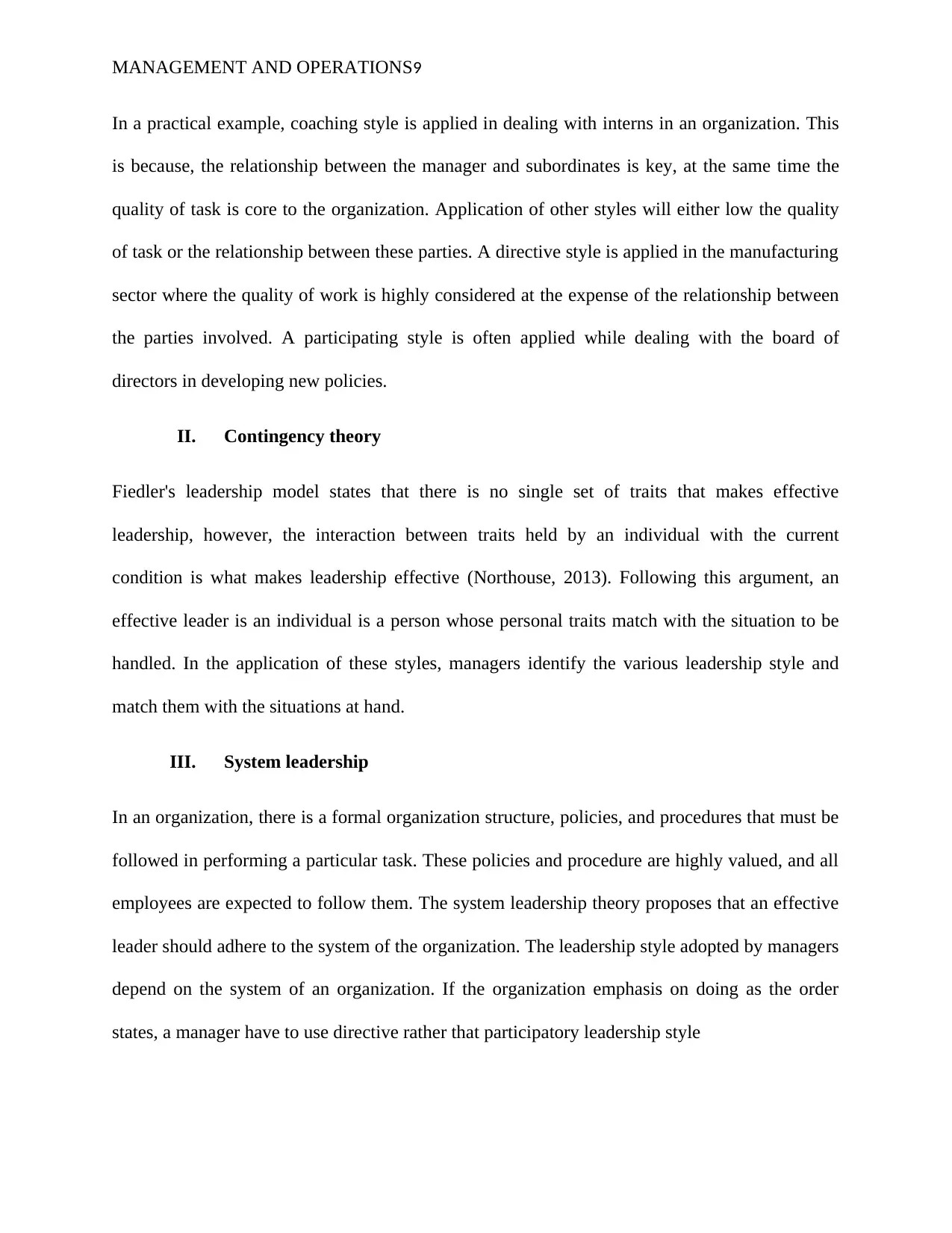
MANAGEMENT AND OPERATIONS9
In a practical example, coaching style is applied in dealing with interns in an organization. This
is because, the relationship between the manager and subordinates is key, at the same time the
quality of task is core to the organization. Application of other styles will either low the quality
of task or the relationship between these parties. A directive style is applied in the manufacturing
sector where the quality of work is highly considered at the expense of the relationship between
the parties involved. A participating style is often applied while dealing with the board of
directors in developing new policies.
II. Contingency theory
Fiedler's leadership model states that there is no single set of traits that makes effective
leadership, however, the interaction between traits held by an individual with the current
condition is what makes leadership effective (Northouse, 2013). Following this argument, an
effective leader is an individual is a person whose personal traits match with the situation to be
handled. In the application of these styles, managers identify the various leadership style and
match them with the situations at hand.
III. System leadership
In an organization, there is a formal organization structure, policies, and procedures that must be
followed in performing a particular task. These policies and procedure are highly valued, and all
employees are expected to follow them. The system leadership theory proposes that an effective
leader should adhere to the system of the organization. The leadership style adopted by managers
depend on the system of an organization. If the organization emphasis on doing as the order
states, a manager have to use directive rather that participatory leadership style
In a practical example, coaching style is applied in dealing with interns in an organization. This
is because, the relationship between the manager and subordinates is key, at the same time the
quality of task is core to the organization. Application of other styles will either low the quality
of task or the relationship between these parties. A directive style is applied in the manufacturing
sector where the quality of work is highly considered at the expense of the relationship between
the parties involved. A participating style is often applied while dealing with the board of
directors in developing new policies.
II. Contingency theory
Fiedler's leadership model states that there is no single set of traits that makes effective
leadership, however, the interaction between traits held by an individual with the current
condition is what makes leadership effective (Northouse, 2013). Following this argument, an
effective leader is an individual is a person whose personal traits match with the situation to be
handled. In the application of these styles, managers identify the various leadership style and
match them with the situations at hand.
III. System leadership
In an organization, there is a formal organization structure, policies, and procedures that must be
followed in performing a particular task. These policies and procedure are highly valued, and all
employees are expected to follow them. The system leadership theory proposes that an effective
leader should adhere to the system of the organization. The leadership style adopted by managers
depend on the system of an organization. If the organization emphasis on doing as the order
states, a manager have to use directive rather that participatory leadership style
⊘ This is a preview!⊘
Do you want full access?
Subscribe today to unlock all pages.

Trusted by 1+ million students worldwide
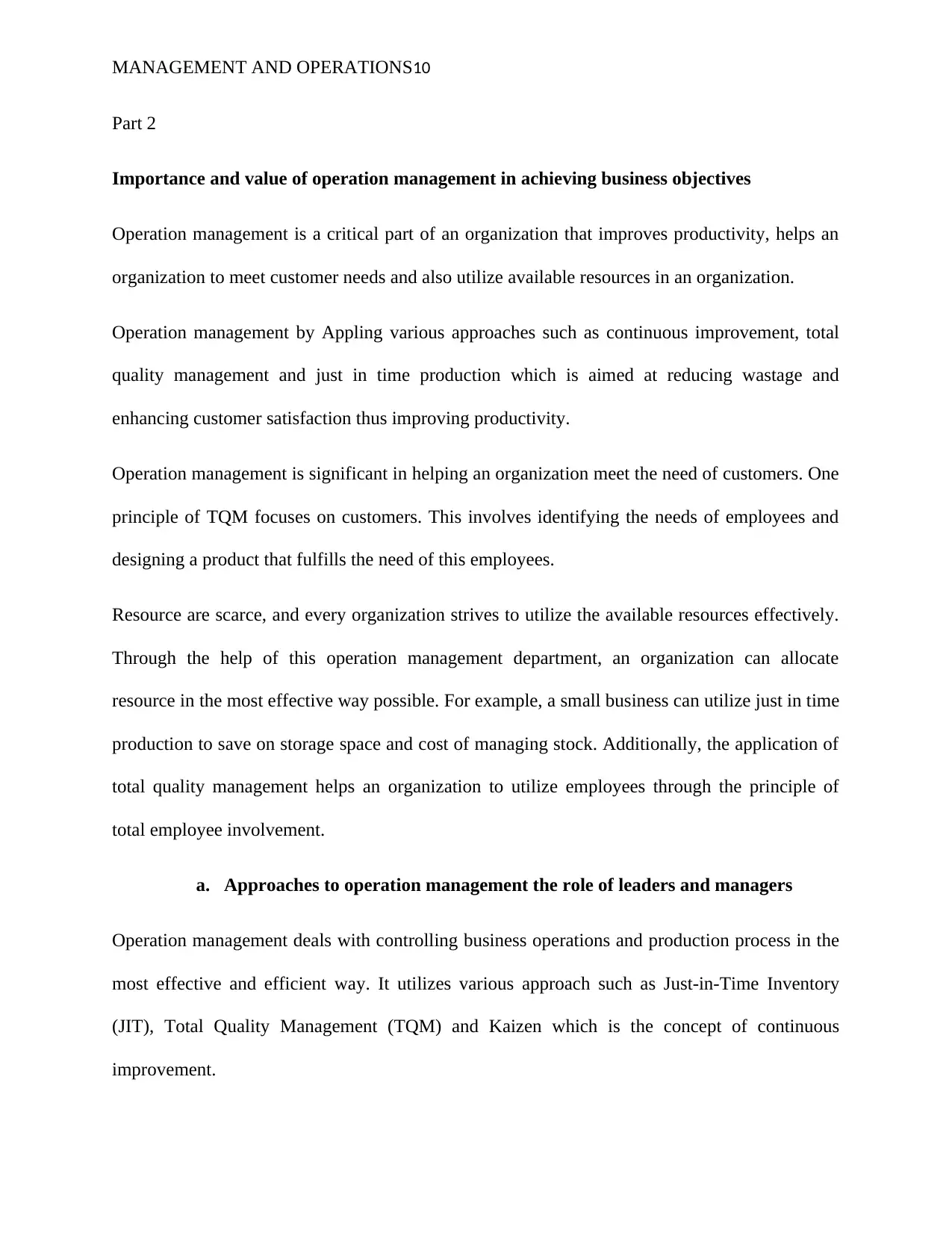
MANAGEMENT AND OPERATIONS10
Part 2
Importance and value of operation management in achieving business objectives
Operation management is a critical part of an organization that improves productivity, helps an
organization to meet customer needs and also utilize available resources in an organization.
Operation management by Appling various approaches such as continuous improvement, total
quality management and just in time production which is aimed at reducing wastage and
enhancing customer satisfaction thus improving productivity.
Operation management is significant in helping an organization meet the need of customers. One
principle of TQM focuses on customers. This involves identifying the needs of employees and
designing a product that fulfills the need of this employees.
Resource are scarce, and every organization strives to utilize the available resources effectively.
Through the help of this operation management department, an organization can allocate
resource in the most effective way possible. For example, a small business can utilize just in time
production to save on storage space and cost of managing stock. Additionally, the application of
total quality management helps an organization to utilize employees through the principle of
total employee involvement.
a. Approaches to operation management the role of leaders and managers
Operation management deals with controlling business operations and production process in the
most effective and efficient way. It utilizes various approach such as Just-in-Time Inventory
(JIT), Total Quality Management (TQM) and Kaizen which is the concept of continuous
improvement.
Part 2
Importance and value of operation management in achieving business objectives
Operation management is a critical part of an organization that improves productivity, helps an
organization to meet customer needs and also utilize available resources in an organization.
Operation management by Appling various approaches such as continuous improvement, total
quality management and just in time production which is aimed at reducing wastage and
enhancing customer satisfaction thus improving productivity.
Operation management is significant in helping an organization meet the need of customers. One
principle of TQM focuses on customers. This involves identifying the needs of employees and
designing a product that fulfills the need of this employees.
Resource are scarce, and every organization strives to utilize the available resources effectively.
Through the help of this operation management department, an organization can allocate
resource in the most effective way possible. For example, a small business can utilize just in time
production to save on storage space and cost of managing stock. Additionally, the application of
total quality management helps an organization to utilize employees through the principle of
total employee involvement.
a. Approaches to operation management the role of leaders and managers
Operation management deals with controlling business operations and production process in the
most effective and efficient way. It utilizes various approach such as Just-in-Time Inventory
(JIT), Total Quality Management (TQM) and Kaizen which is the concept of continuous
improvement.
Paraphrase This Document
Need a fresh take? Get an instant paraphrase of this document with our AI Paraphraser
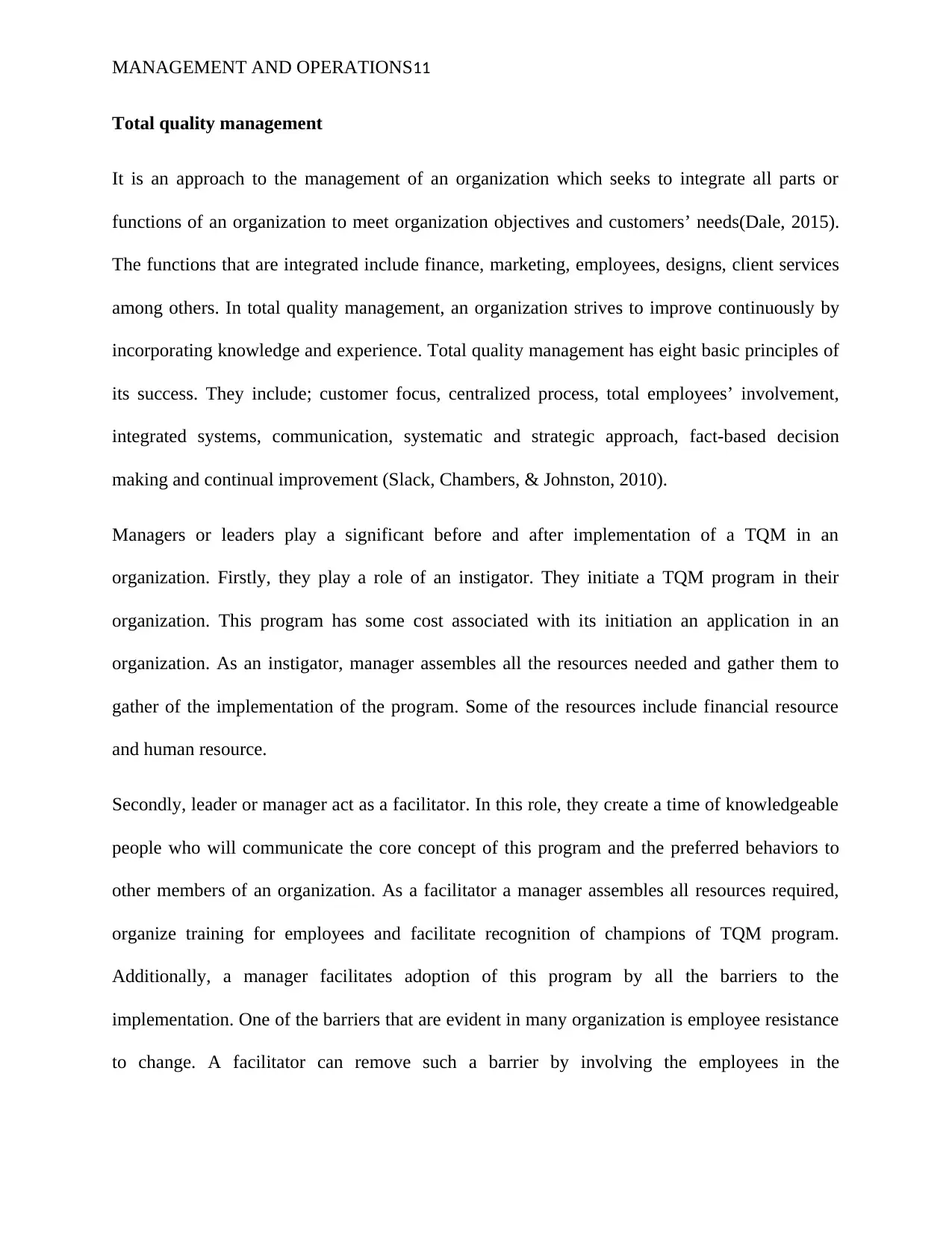
MANAGEMENT AND OPERATIONS11
Total quality management
It is an approach to the management of an organization which seeks to integrate all parts or
functions of an organization to meet organization objectives and customers’ needs(Dale, 2015).
The functions that are integrated include finance, marketing, employees, designs, client services
among others. In total quality management, an organization strives to improve continuously by
incorporating knowledge and experience. Total quality management has eight basic principles of
its success. They include; customer focus, centralized process, total employees’ involvement,
integrated systems, communication, systematic and strategic approach, fact-based decision
making and continual improvement (Slack, Chambers, & Johnston, 2010).
Managers or leaders play a significant before and after implementation of a TQM in an
organization. Firstly, they play a role of an instigator. They initiate a TQM program in their
organization. This program has some cost associated with its initiation an application in an
organization. As an instigator, manager assembles all the resources needed and gather them to
gather of the implementation of the program. Some of the resources include financial resource
and human resource.
Secondly, leader or manager act as a facilitator. In this role, they create a time of knowledgeable
people who will communicate the core concept of this program and the preferred behaviors to
other members of an organization. As a facilitator a manager assembles all resources required,
organize training for employees and facilitate recognition of champions of TQM program.
Additionally, a manager facilitates adoption of this program by all the barriers to the
implementation. One of the barriers that are evident in many organization is employee resistance
to change. A facilitator can remove such a barrier by involving the employees in the
Total quality management
It is an approach to the management of an organization which seeks to integrate all parts or
functions of an organization to meet organization objectives and customers’ needs(Dale, 2015).
The functions that are integrated include finance, marketing, employees, designs, client services
among others. In total quality management, an organization strives to improve continuously by
incorporating knowledge and experience. Total quality management has eight basic principles of
its success. They include; customer focus, centralized process, total employees’ involvement,
integrated systems, communication, systematic and strategic approach, fact-based decision
making and continual improvement (Slack, Chambers, & Johnston, 2010).
Managers or leaders play a significant before and after implementation of a TQM in an
organization. Firstly, they play a role of an instigator. They initiate a TQM program in their
organization. This program has some cost associated with its initiation an application in an
organization. As an instigator, manager assembles all the resources needed and gather them to
gather of the implementation of the program. Some of the resources include financial resource
and human resource.
Secondly, leader or manager act as a facilitator. In this role, they create a time of knowledgeable
people who will communicate the core concept of this program and the preferred behaviors to
other members of an organization. As a facilitator a manager assembles all resources required,
organize training for employees and facilitate recognition of champions of TQM program.
Additionally, a manager facilitates adoption of this program by all the barriers to the
implementation. One of the barriers that are evident in many organization is employee resistance
to change. A facilitator can remove such a barrier by involving the employees in the
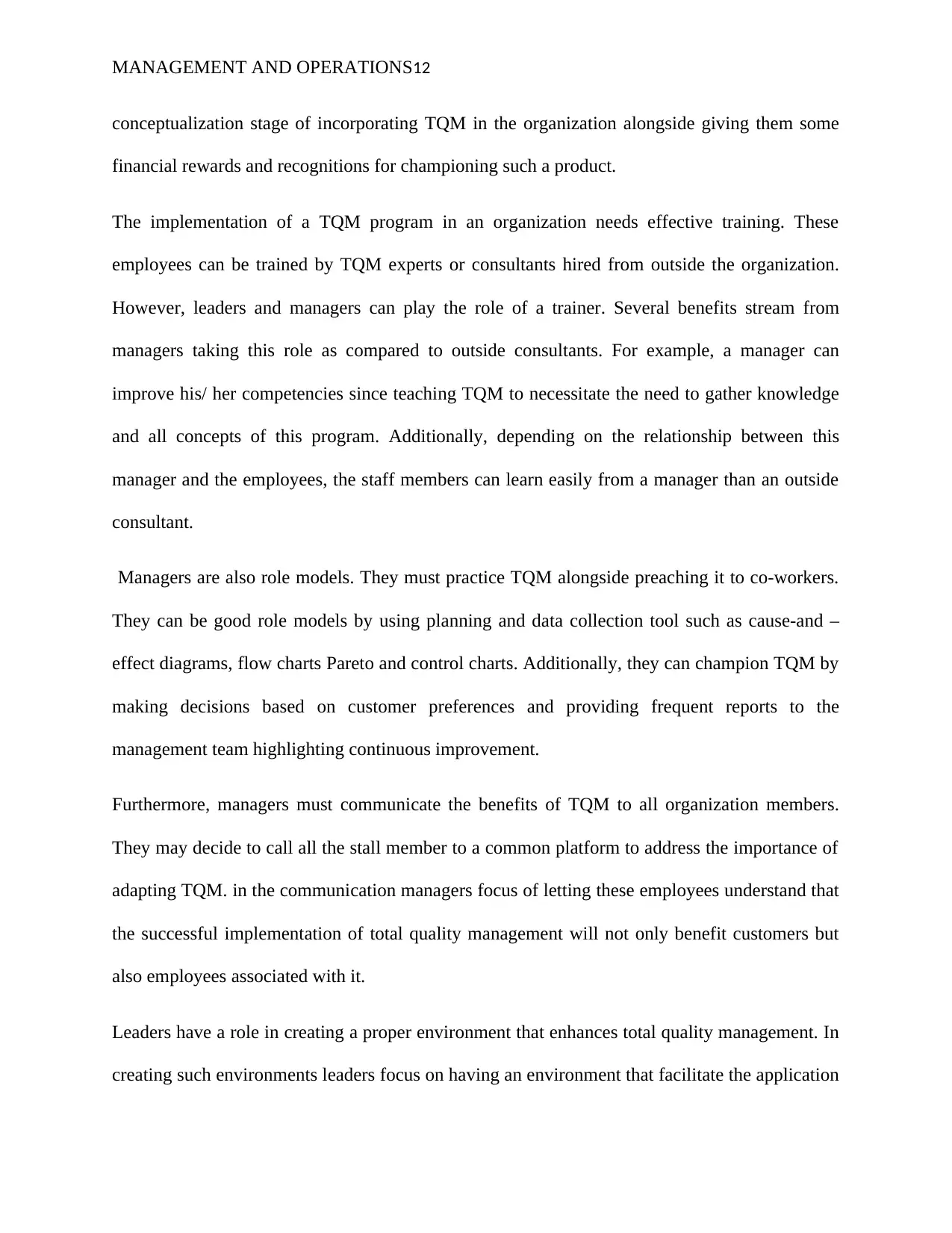
MANAGEMENT AND OPERATIONS12
conceptualization stage of incorporating TQM in the organization alongside giving them some
financial rewards and recognitions for championing such a product.
The implementation of a TQM program in an organization needs effective training. These
employees can be trained by TQM experts or consultants hired from outside the organization.
However, leaders and managers can play the role of a trainer. Several benefits stream from
managers taking this role as compared to outside consultants. For example, a manager can
improve his/ her competencies since teaching TQM to necessitate the need to gather knowledge
and all concepts of this program. Additionally, depending on the relationship between this
manager and the employees, the staff members can learn easily from a manager than an outside
consultant.
Managers are also role models. They must practice TQM alongside preaching it to co-workers.
They can be good role models by using planning and data collection tool such as cause-and –
effect diagrams, flow charts Pareto and control charts. Additionally, they can champion TQM by
making decisions based on customer preferences and providing frequent reports to the
management team highlighting continuous improvement.
Furthermore, managers must communicate the benefits of TQM to all organization members.
They may decide to call all the stall member to a common platform to address the importance of
adapting TQM. in the communication managers focus of letting these employees understand that
the successful implementation of total quality management will not only benefit customers but
also employees associated with it.
Leaders have a role in creating a proper environment that enhances total quality management. In
creating such environments leaders focus on having an environment that facilitate the application
conceptualization stage of incorporating TQM in the organization alongside giving them some
financial rewards and recognitions for championing such a product.
The implementation of a TQM program in an organization needs effective training. These
employees can be trained by TQM experts or consultants hired from outside the organization.
However, leaders and managers can play the role of a trainer. Several benefits stream from
managers taking this role as compared to outside consultants. For example, a manager can
improve his/ her competencies since teaching TQM to necessitate the need to gather knowledge
and all concepts of this program. Additionally, depending on the relationship between this
manager and the employees, the staff members can learn easily from a manager than an outside
consultant.
Managers are also role models. They must practice TQM alongside preaching it to co-workers.
They can be good role models by using planning and data collection tool such as cause-and –
effect diagrams, flow charts Pareto and control charts. Additionally, they can champion TQM by
making decisions based on customer preferences and providing frequent reports to the
management team highlighting continuous improvement.
Furthermore, managers must communicate the benefits of TQM to all organization members.
They may decide to call all the stall member to a common platform to address the importance of
adapting TQM. in the communication managers focus of letting these employees understand that
the successful implementation of total quality management will not only benefit customers but
also employees associated with it.
Leaders have a role in creating a proper environment that enhances total quality management. In
creating such environments leaders focus on having an environment that facilitate the application
⊘ This is a preview!⊘
Do you want full access?
Subscribe today to unlock all pages.

Trusted by 1+ million students worldwide
1 out of 20
Related Documents
Your All-in-One AI-Powered Toolkit for Academic Success.
+13062052269
info@desklib.com
Available 24*7 on WhatsApp / Email
![[object Object]](/_next/static/media/star-bottom.7253800d.svg)
Unlock your academic potential
Copyright © 2020–2025 A2Z Services. All Rights Reserved. Developed and managed by ZUCOL.



